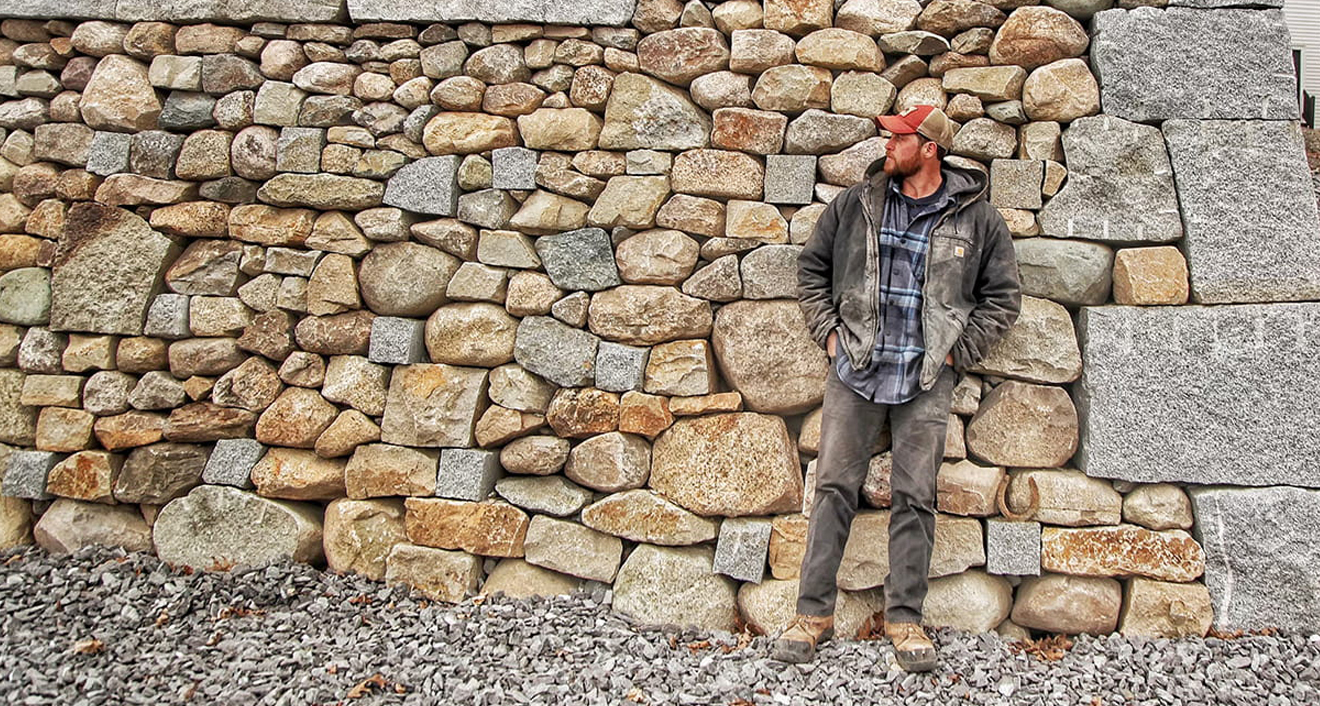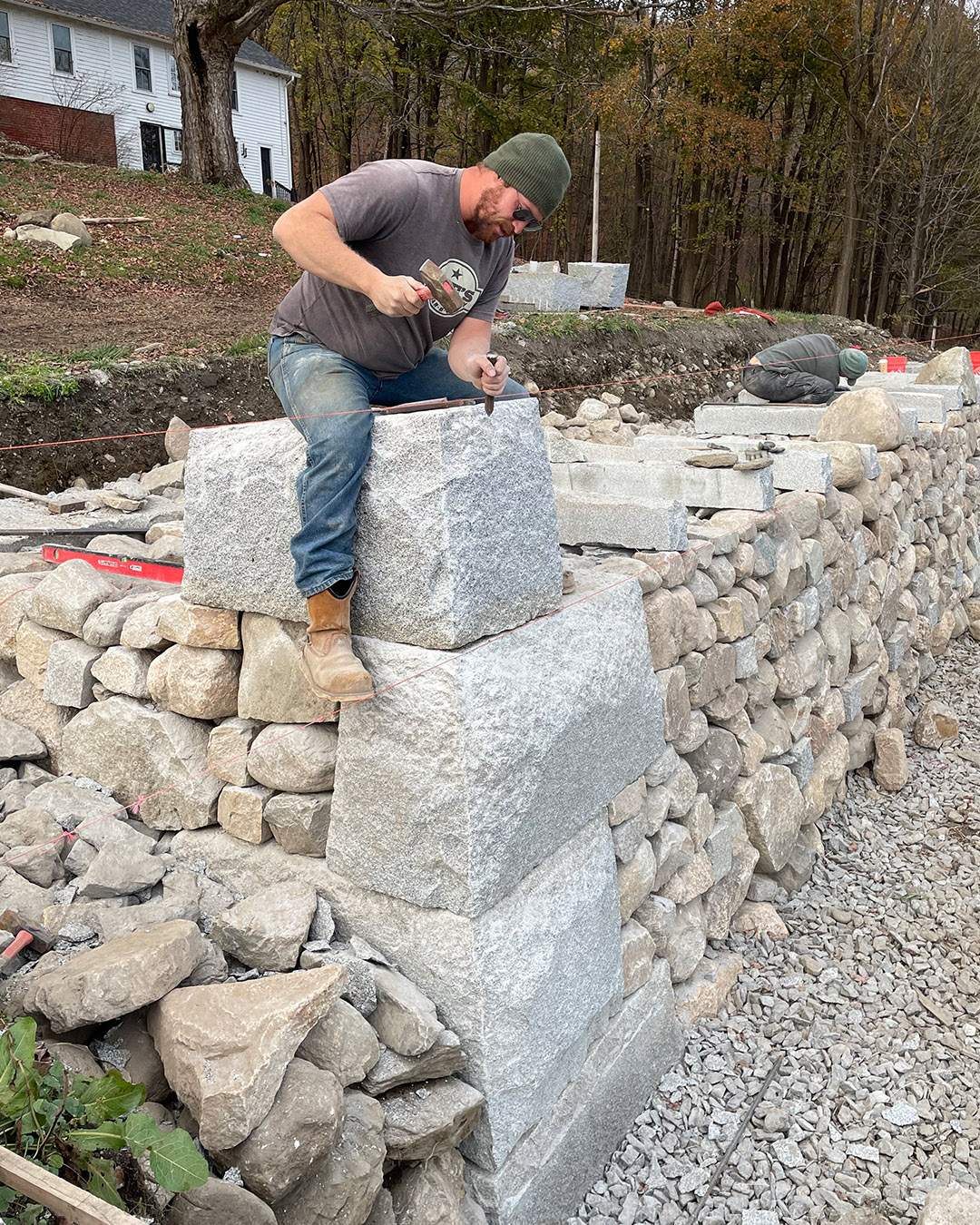
Bryce Hollingsworth ’13 and the Ancient Art of Dry Stone Walling

About a decade ago, Bryce Hollingsworth ’13 ditched his disenchanting white-collar job without a clear sense of where his future was headed—until he stumbled upon the art of dry stone walling. The name of the thousands-year-old trade is also its method: Instead of troweling mortar onto neatly prefabricated blocks, dry stone craftspeople create structures with nothing more than rough fieldstones—often excavated on site—and the physics of careful arrangement. “This wasn’t some abstract thought experiment,” says Hollingsworth, an economics and international relations major recruited to Wesleyan for the men’s crew varsity eight. “There was a pile of rocks [before], and now there’s a wall.”
Pursuing the craft took him from New England to Wyoming, Ireland, Japan, and points beyond. Along the way, he attained advanced skills, executed commissions, and, in 2018, founded the dry stone walling contractor Stone Bear Mason. After a day spent working on a client’s retaining wall near his home in western Massachusetts, Hollingsworth spoke with Wesleyan University Magazine about finding the second act of his working life, the basics of building without mortar, and what he made from more than 300 tons of stone.
Bryce Hollingsworth ’13: I grew up in Houston and worked a lot of manual labor jobs—construction for my Uncle Jay in Kentucky during the summers, landscaping, ditch digging, that kind of stuff. I always liked working with my hands, even at Wes. I wasn't part of the permaculture group, but I had a truck with an eight-foot bed, and when they had planting days, I'd help haul stuff, plant trees, dig holes, all that.
I thought, I'm going to major in economics and I'm going to get a good job—whatever that means. I graduated and became an analyst for General Electric in their Energy Financial Services Group. Sitting at a desk was terrible—my whole life I'd been an athlete using my body, but when you stop being an athlete you're supposed to cram into a chair. I was going to the gym all the time just to get that fix. I got a job offer from an oil and gas company back in Houston—better pay, more responsibility . . . I looked around at the other people in my field, and I saw a lot of people who were making a whole lot of money who were very unhappy.
One day I saw a post on Craigslist. [The employer] was a jack of all trades and he did mortar work, but he also did dry stone walls. The job post was something like: Looking for a laborer who can handle physically demanding work. I've had seven people quit in seven months; no one has lasted longer than three weeks. You will not be paid much to start. We had a complicated relationship, but I was immediately so much happier at that job.

After satisfaction proved elusive when he worked in an office, changing careers and learning the techniques of dry stone walling captivated Hollingsworth. "You get in the zone and, suddenly," he says, "eight hours passed and you forgot to eat."
I got super-focused on dry stone—reading every book I could about it, hitting up guys after I'd see their work. I found out about The Stone Trust and I started working for different people to absorb as much as I could and work as hard as possible. I liked how tangible stone is and, honestly, I liked it because I wasn't very good at it. It was fun to learn and see that improvement, to see [my] spatial awareness develop. You get in the zone and, suddenly, eight hours passed and you forgot to eat.
Building with stone [and] without mortar is one of the oldest types of construction that we have. A lot of dry stone walls that I repair or rebuild are 300 years old. I've seen dry stone walls that are over 1,000 years old and, you know, they're fine.
Dry stone allows for the flex and movement of the earth, allows for water to pass through, and if a section does get compromised, generally only that section will fail and it can be easily repaired. Mortared walls don’t have that same kind of flexion. They’re rigid. When they fail, generally the whole wall cracks after a large build-up of stress over time. They also tend to hold onto water, which freezes and expands, causing cracks and blowouts. Especially in New England, where the freeze-thaw cycle is so aggressive, dry stone walls—built properly—tend to last significantly longer.
A dry stone wall is just friction and gravity: the pressure goes down and out, like a pyramid. Generally speaking, your biggest stones are at the bottom, your smallest ones are at the top. A lot of mortar walls are plumb because the structural integrity of that wall is being generated differently; you wouldn't build [dry stone] walls plumb because then they would just fall over. But by allowing pressure and weight to move down and out, you maximize the friction coefficient of the stone.
Ideally, your foundation stones on either side of the wall touch in the middle—you’re basically building two parallel walls. You pack the middle with hearting, trying to fill up any air gaps with the fewest number of rocks possible. You don’t just dump a bunch of gravel in there—gravel has no structural integrity. You want as much contact and friction as possible to create connection, front to back. About halfway up that wall, you're ready for what are called through stones—they tie the two halves of the wall together. Once you've built all the way to your top height, packing tight and reducing air space as best you can, then you're ready for cope stones that span the width of the top of the wall. That ties the two halves of the wall together and, also, acts as a roof, allowing water to shed to either side to help a wall last longer.
I didn't really have a formal education in this. I just looked to people who were doing the best work and hit them up: “Hey, I'd love to work with you for a couple weeks.” I had taken my initial certification through the Dry Stone Walling Association of Great Britain, and through their network I got connected to Geoff Duggan, a master craftsman in Australia. I went out there for two months in the winter, lived in his woodshed—he made a bed for me out of milk crates and a mattress—and I just worked with him and his son for two months. I applied for a grant through the Preservation Trades Network, used it to go to Ireland for three weeks and worked with a waller named Fergus Packman out near Galway and learned a different style. The best way to get better is just work with people who are way better than you, who work with a stone you've never worked with.
I've done work all over the US, both my [own] jobs and collaborations with other guys that I really respect and admire. It sharpened my skills working with bassalt on the West Coast, working with granite in Maine, going down to Kentucky to play with their limestone. There's so many different styles, so many different types of stone, and so many guys just stay in their area. That's going to limit how good you can get. I want to be able to build anything out of anything.
In 2021, a master craftsman that I know, Brian Post, had gotten the contract to do restoration work at Opus 40 in Saugerties, New York, the largest stone sculpture park in the US. It was a pretty huge undertaking—I was working on a section of wall that was 15 feet high that we had to rip out and rebuild because it was failing, and building something of that scale was huge for me. Then I did my first big travel job out in Indiana, building two entrance walls that each curve to a corner after going around a radius, and then 90-degree’d off into a straight wall—that was a technically difficult build. Then, a woman I know, Thea Alvin, got a contract to build a 1,000-foot-long stone labyrinth in the Smoky Mountains and I was on that crew. It was all quartzite, round stone boulders all excavated on site and we built it right there: a thousand tons of stone in five weeks.

Over the span of 11 weeks, Hollingsworth and company built a 12-foot tall, 8-foot thick retaining wall from than 300 tons of stone, engineered to withstand the steep pitch of the site and, eventually, support a covered bridge.
My favorite jobs serve a purpose—retaining walls, bridges, some kind of structure that's doing something and not just looking pretty. There was a 1700s timber-frame barn that was going to be torn down and restored, and the timber framer hit me up: there was [also] this concrete wall that had cracked and failed. [The property owner] wanted to replace it with a retaining wall that used the stone from the barn’s original foundation, and they wanted to have a 20-foot long, 15-foot wide timber-frame covered bridge come out of the barn and sit on this [new] wall. There’s a huge, drastic elevation change: the [property owner’s] house is at the top of this huge hill, and the barn is at the bottom—a lot of soil, a lot of water, a lot of pressure. The wall is very functional—it's holding up what the house is sitting on, and it's got to have the structural integrity to carry a covered bridge.
I put a lot of time and energy into thinking that design out before we started building. Walls fail most often at the corners and ends—pressure spans the plane of a wall and will move to the corners, especially if it’s a retaining wall—so I knew the corners and ends needed to be super-stout to deal with all the pressure and weight. I got some large granite quarry blocks and shaped those up to maximize the amount of contact and friction; each of those corner blocks is, like, two tons a piece, and I shaped them all by hand. We used the stone from the original foundation, but we still had to bring in another 300 tons [of stone], as close to a geologic match as we could find that would look appropriate. The wall, on average, was about six feet thick, then we built out a notch to receive the bridge with flat granite caps.
There are plenty of other people I know who do good work but don't do a good job running the books. The education I got at Wesleyan allowed me to run my business better. Honestly, [after] going to Wesleyan, I feel pretty comfortable talking to anybody about anything. Talking to your clients as people and not just as the stone guy makes a big difference.
I haven't had fingerprints in years. It's really frustrating sometimes. I went to Japan last fall to do some work with some Japanese masons over there, and when I arrived, [the customs officials] wanted my passport and my fingerprints. “Why don't you have fingerprints?” Man, I don't know what to tell you.



